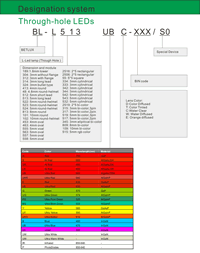smd-chip led
Series No:
Weight:(g/pcs)
Dimension:(mm)
Package:
Specification:
Inquiry
Description:
The 1204 bi-color SMD LED with side emitting capabilities is transforming the way industries utilize LEDs in their products, providing both functional and aesthetic enhancements. This article delves into the features, applications, and benefits of the 1204 bi-color SMD LED, supported by compelling case studies and user testimonials. Aimed at electronics manufacturers, engineers, and purchasers, this guide underscores how these LEDs can elevate product designs and functionality.
Innovative Features of the 1204 Bi-Color SMD LED, Side Emitting
The 1204 bi-color SMD LED is celebrated for its dual-light output and compact design, making it an excellent choice for various applications. Key features include:
- Bi-Color Functionality: Combines two distinct colors in one small package, allowing for creative lighting solutions without additional space or power.
- Side Emitting: Emits light from the side, perfect for applications requiring directional light such as edge lighting.
- High Efficiency: Despite the dual-color functionality, it maintains energy efficiency, making it a cost-effective option for widespread use.
Applications of the 1204 Bi-Color SMD LED
This LED is highly versatile, finding applications across a broad spectrum of industries:
- Consumer Electronics: Used in devices like smartphones and tablets for notifications and buttons, enhancing user interface with color-coded alerts.
- Automotive: Ideal for interior and dashboard lighting, offering enhanced visibility and style with customizable color options.
- Signage and Decorative Lighting: Perfect for commercial signage, providing striking visual displays that attract attention and communicate messages effectively.
Benefits of Using 1204 Bi-Color SMD LEDs
The integration of 1204 bi-color SMD LEDs offers substantial advantages:
- Enhanced Product Design: Allows designers to incorporate multi-color LEDs without compromising on space, enhancing both functionality and aesthetic appeal.
- Energy and Cost Efficiency: Reduces power consumption and lowers overall product costs by combining two colors into a single LED.
- Improved User Experience: Enables more interactive and engaging designs, which can be tailored to specific functions and user needs.
Case Studies: Real-World Impact of 1204 Bi-Color SMD LEDs
- Smartphone Enhancement: A leading mobile manufacturer used the 1204 bi-color LEDs to introduce new notification features, significantly improving user satisfaction and device functionality.
- Innovative Retail Signage: A retail chain implemented these LEDs in their new signage, resulting in increased customer engagement and sales due to the effective use of dynamic, eye-catching displays.
User Testimonials
- David Chen, Electronics Designer at Innovative Tech Solutions: “The 1204 bi-color SMD LEDs have allowed us to drastically improve the visual appeal of our products while maintaining cost efficiency.”
- Emma Lopez, Procurement Director at AutoDesigns: “These LEDs have revolutionized our approach to interior car lighting, providing us with the ability to offer customizable options to our customers.”
Conclusion: Why Opt for 1204 Bi-Color SMD LED, Side Emitting?
The 1204 bi-color SMD LED, side emitting, stands out as a leader in advanced LED technology. Offering both versatility in application and efficiency in design, these LEDs are an essential component for any forward-thinking electronics project, enhancing both the usability and the aesthetics of end products.
Call to Action: Elevate your design capabilities with the innovative 1204 bi-color SMD LED. Contact us today to learn more about how these LEDs can transform your projects and products!

Features
- 3.2mm x 1.0mm SMD, 1.5mm Thickness: This Surface-Mount Device (SMD) LED is compact and thin, making it ideal for space-constrained applications. Its size and form factor are particularly suited for high-density mounting on circuit boards.
- Bi-Color Type: The LED can emit two different colors, adding versatility to its use in various signaling and display applications.
- Side Emitting: Specifically designed to emit light from the sides, making it suitable for edge lighting and applications where directional lighting is required.
- Compatible with Automatic Placement Equipment: Designed for easy integration with automated assembly lines, enabling efficient and precise placement in manufacturing.
- Wide Viewing Angle: Its design ensures a broad viewing angle, particularly useful for side-emitting LEDs where wide directional light is required.
- Ideal for Backlight and Indicator: Perfectly suited for use as a backlight in display panels or as a multi-colored indicator in electronic devices.
- Packaged 3,000 Pieces per Reel: Supplied in bulk, with 3,000 pieces per reel, optimizing for bulk manufacturing and facilitating efficient handling.
- RoHS Compliance: Manufactured in accordance with the Restriction of Hazardous Substances directive, ensuring environmentally safer production and use.
Applications
- Edge-Lit Displays: Ideal for edge-lighting in display panels, signage, and advertising boards, where the bi-color and side-emitting features can be utilized effectively.
- Backlighting in Thin Displays: Suitable for backlighting ultra-thin displays in consumer electronics, where traditional top-emitting LEDs may not be practical.
- Automotive Interior Lighting: Can be used for interior lighting in vehicles, such as dashboard lighting and control panels, benefiting from the directional bi-color light.
- Status Indicators: Perfect for dual-color indicators in various electronic devices, appliances, and machinery, providing clear and distinct signaling.
- Consumer Electronics: Useful in personal devices like smartphones and tablets, particularly in applications requiring compact, side-emitting, and bi-color LEDs.
- Illumination in Narrow Spaces: Well-suited for lighting applications in confined or narrow spaces within electronic devices.
- Portable and Wearable Electronics: Given its small size, bi-color capability, and side-emitting feature, it’s ideal for portable and wearable technology.
- Decorative and Ambient Lighting: Suitable for creating mood and ambient lighting effects in architectural designs and interior decoration.


Electrical-optical characteristics:
Package configuration & Internal circuit diagram
Obtain 3D specification files
To examine all 3D specifications, save the files to your local drive and open them with your 3D application.
Lens colors in 3D files are solely for visual representation; consult the Datasheet for accurate lens type and color information.
In the event of a mismatch, the dimensions in the datasheet take precedence over the 3D specifications.

All dimensions are in millimeters(inches)
Tolerance is +-0.25(0.01″) unless otherwise note
Specifications are subject to change without notice.
Partno description:
More Information
Lens Color:
| Code | D | T | C | W | E | |
| Meaning | color Diffused | Color Tinted | Water Clear | Water Diffused | Orange diffused |
Absolute maximum ratings (Ta=25°C)
| Parameter | SR | LR | UR | UE | UY | UG | PG | BG | B | UB | UV | W | Unit |
| Forward Current I F | 25 | 25 | 25 | 30 | 30 | 30 | 30 | 30 | 30 | 30 | 30 | 30 | mA |
| Power Dissipation P d | 60 | 60 | 60 | 65 | 65 | 75 | 110 | 110 | 120 | 120 | 120 | 120 | mW |
| Reverse Voltage V R | 5 | 5 | 5 | 5 | 5 | 5 | 5 | 5 | 5 | 5 | 5 | 5 | V |
| Peak Forward Current I PF (Duty 1/10 @1KHZ) | 150 | 150 | 150 | 150 | 150 | 150 | 150 | 100 | 100 | 100 | 100 | 100 | mA |
| Operation Temperature T OPR | -40 to +80 | °C | |||||||||||
| Storage Temperature T STG | -40 to +85 | °C | |||||||||||
| Lead Soldering Temperature T SOL | Max.260+-5°C for 3 sec Max. (1.6mm from the base of the epoxy bulb) | °C | |||||||||||
Related Information
Applied for: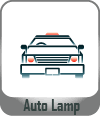
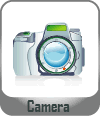
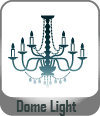
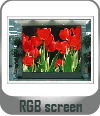
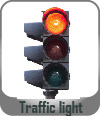
The LEDs described here are intended to be used for ordinary electronic equipment (such as office equipment,
communication equipment and household applications). Consult Betlux’s Sales in advance for information on
applications in which exceptional reliability is required, particularly when the failure or malfunction of the LEDs
may directly jeopardize life or health (such as in aviation, transportation, traffic control equipment, medical
and life support systems and safety devices).
CAUTIONS for Through-Hole LED Lamps
1. Application
The LEDs described here are intended to be used for ordinary electronic equipment (such as office equipment, communication equipment and household applications). Consult Betlux’s Sales in advance for information on applications in which exceptional reliability is required, particularly when the failure or malfunction of the LEDs may directly jeopardize life or health (such as in aviation, transportation, traffic control equipment, medical and life support systems and safety devices).
2. Storage
The storage ambient for the LEDs should not exceed 30℃ temperature or 70% relative humidity. It is
recommended that LEDs out of their original packaging are used within three months
For extended storage out of their original packaging, it is recommended that the LEDs be stored in a sealed
container with appropriate desiccant or in a desiccator with nitrogen ambient.
3. Cleaning
Use alcohol-based cleaning solvents such as isopropyl alcohol to clean the LED if necessary
4. Lead Forming & Assembly
During lead forming, the leads should be bent at a point at least 3mm from the base of LED lens. Do not use
the base of the leadframe as a fulcrum during forming.
Lead forming must be done before soldering, at normal temperature.
During assembly on PCB, use minimum clinch force possible to avoid excessive mechanical stress.
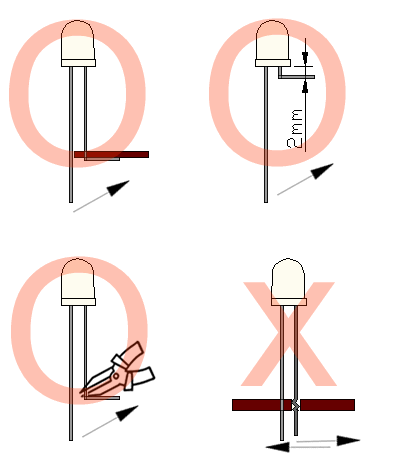
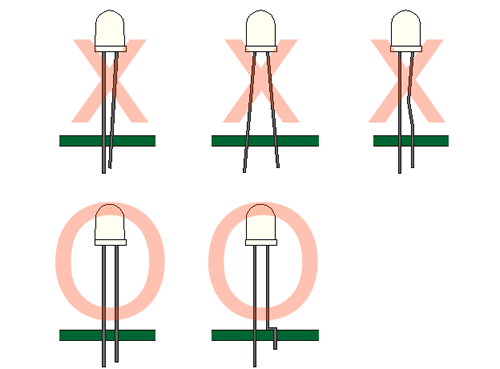
Soldering
When soldering, leave a minimum of 2mm clearance from the base of the base of the lens to the soldering point. Dipping the lens into the solder must be avoided.
Do not apply any external stress to the lead frame during soldering while the LED is at high temperature.
Recommended soldering conditions:
| IR Reflow Soldering (for SMD display) | Wave Soldering | Soldering Iron | |||
| Pre-Heat | 150-180°C | Pre-Heat | 100°C Max. | Temperature | 300°C Max. |
| Pre-Heat Time | 120sec Max. | Pre-Heat Time | 60sec Max. | ||
| Peak Temperature | 260°C Max. | SolderWave | 260°C Max. | Soldering Time | 3sec Max.(one time only) |
| Soldering Time | 10 sec Max. | Soldering Time | 5sec Max. | ||
Note: Excessive soldering temperature and/or time might result in deformation of the LED lens or failure of the LED
ESD(Electrostatic Discharge)
Static Electricity or power surge will damage the LED.
Suggestions to prevent ESD (Electrostatic Discharge):
n Use a conductive wrist band or anti-electrostatic glove when handling these LEDs
n All devices, equipment, and machinery must be properly grounded
n Work tables, storage racks, etc. should be properly grounded
n Use ion blower to neutralize the static charge which might have built up on surface of the LED’s
plastic lens as a result of friction between LEDs during storage and handling
ESD-damaged LEDs will exhibit abnormal characteristics such as high reverse leakage current,
low forward voltage, or “no light on” at low currents. To verify for ESD damage, check for “light on”
and Vf of the suspect LEDs at low currents.
The Vf of “good” LEDs should be>2.0V@0.1mA for InGaN product and >1.4V@0.1mA for AlInGaP
product.

Drive Method
An LED is a current-operated device. In order to ensure intensity uniformity on multiple LEDs connected in
parallel in an application, it is recommended that a current limiting resistor be incorporated in the drive circuit,
in series with each LED as shown in Circuit A below.
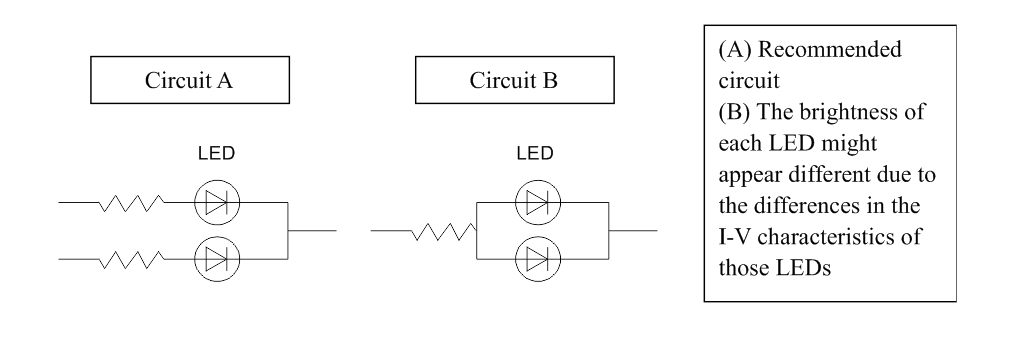
When selecting power for LED systems, it’s essential to understand several key parameters to ensure safe operation, longevity, and optimal performance. Here are some steps and considerations for LED power selection:
- Determine the Forward Voltage (Vf) of the LED(s):
Each LED has a forward voltage, which is the voltage at which the LED operates when the current is flowing through it. This value can typically be found in the LED’s datasheet.
- Determine the Forward Current (If) of the LED(s):
The forward current is the current at which the LED is designed to operate. Running an LED at higher than its rated current can reduce its lifespan and increase the heat it produces.
- Decide on the Configuration:
Series Configuration: When LEDs are connected in series, the forward voltages add up, but the current remains the same.
Parallel Configuration: When LEDs are connected in parallel, the forward voltage remains the same, but the currents add up. This configuration can be risky because if one LED fails or has a slightly lower forward voltage, it can cause the other LEDs to draw more current.
Calculate Total Power Requirements:
Power (W) = Total Forward Voltage (V) x Total Forward Current (A)
For example, if you have three LEDs connected in series, each with a forward voltage of 3V and a forward current of 20mA, the total power requirement would be:
Power = (3V + 3V + 3V) x 20mA = 9V x 0.02A = 0.18W
- Select an Appropriate Power Supply:
- Voltage Rating: The power supply voltage should match or slightly exceed the total forward voltage of your LED configuration.
- Current Rating: The power supply’s current rating should meet or exceed the total forward current of your LED configuration.
- Safety Margin: It’s a good practice to select a power supply that can provide at least 20% more power than your calculated requirement. This ensures the power supply isn’t operating at its maximum capacity, which can extend its life and ensure safer operation.
- Consider Additional Features:
- Dimming Capability: If you want to control the brightness of your LEDs, choose a power supply with dimming capabilities.
- Overcurrent and Overvoltage Protection: To protect your LEDs, select a power supply with built-in protection mechanisms.
- Thermal Management: Ensure that the power supply has adequate cooling, especially if it will be enclosed or in a location with limited airflow.
- Regulation and Efficiency:A power supply with good regulation will maintain a consistent voltage output despite variations in the load. High efficiency ensures minimal power is wasted as heat.
- Physical Size and Form Factor:Depending on where you plan to place the power supply, its size and shape may be critical factors.
In summary, when selecting power for LED systems, understanding your LED’s requirements and the configuration you plan to use is essential. Then, pick a power supply that meets those needs with some added safety margin, keeping in mind any additional features or constraints relevant to your project.
Here are some well-regarded brands in the industry:
- Mean Well: One of the most recognized brands in the LED power supply industry, Mean Well offers a wide range of products suitable for both indoor and outdoor applications. Their units often come with features like overcurrent protection, dimming capabilities, and high efficiency.
- Tridonic: A global leader in lighting technology, Tridonic offers LED drivers and power supplies that cater to various lighting solutions, from simple setups to advanced smart lighting systems.
- Philips Advance Xitanium: Philips is a well-known brand in the lighting industry, and their Xitanium series of LED drivers are known for reliability and performance. They cater to both indoor and outdoor LED applications.
- Osram: Another giant in the lighting industry, Osram offers a range of LED drivers and power supplies suitable for various applications, including architectural and street lighting.
- LIFUD: Specializing in LED drivers, LIFUD is known for its high-quality products that cater to both commercial and residential LED lighting solutions.
- MOSO: This brand offers a variety of LED drivers, especially for outdoor and industrial applications. Their products are known for durability and performance.
- TDK-Lambda: With a history in power electronics, TDK-Lambda offers a range of power supplies and LED drivers suitable for various applications, emphasizing reliability and advanced features.

